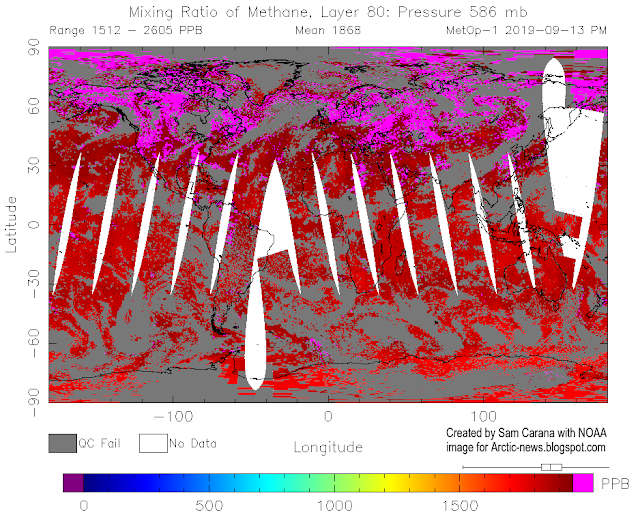In July 2019, a critical tipping point was crossed. July sea surface temperatures on the Northern Hemisphere were 1.07°C above what they were during the 20th century, as illustrated by above image which has a trend added that points at 5°C above the 20th century by 2033.
Why is 1°C above 20th century's temperature such a critical tipping point for the sea surface on the Northern Hemisphere? Let's first take a look at where global heating is going.

Oceans are absorbing over 90% of global heating, as illustrated by above image. Due to the high greenhouse gas levels resulting from people's emissions, oceans keep on getting hotter, and given oceans' huge heat-absorbing capacity, it has taken many years before this tipping point was crossed.
In July 2016, the tipping point was touched at 0.99°C. In July 2017, the July temperature anomaly was on the tipping point, at exactly 1°C. In July 2018, the sea surface was a bit cooler, and the tipping point was crossed in July 2019 when the temperature anomaly was 1.07°C above the 20th century average.
 |
Arctic sea ice used to absorb 0.8% of global heating (in 1993 to 2003). Ocean heat keeps flowing into the Arctic Ocean, carried by ocean currents, as illustrated by above image. As peak heat arrives in the Arctic Ocean, it melts sea ice from below.
The image below shows sea surface temperatures on August 13, 2019 (left) and on September 9, 2019 (right). The light blue line forms a line indicating the sea surface temperature there is 0°C. That light blue line has moved pole-ward in September, due to rivers that kept adding warm water and also due to more warmer water entering the Arctic Ocean from the Atlantic Ocean and the Pacific Ocean.
As above image also shows, the sea surface near Svalbard was 20.4°C (or 68.7°F) at the area marked by the green circle on August 13, 2019 (left), and 20.3°C (or 68.5°F) on September 9, 2019 (right), indicating how high the temperature of the water can be underneath the surface, as it moves into the Arctic Ocean. In other words, further ocean heat is still entering the Arctic Ocean.
From mid August 2019, ocean heat could no longer find any sea ice to melt, since the thick sea ice that hangs underneath the surface had already disappeared. A thin layer of sea ice at the surface was all that remained, as air temperatures didn't come down enough to melt it from above.
This indicates that the buffer has gone that has until now been consuming ocean heat as part of the melting process. As long as there is sea ice in the water, this sea ice will keep absorbing heat as it melts, so the temperature will not rise at the sea surface. The amount of energy absorbed by melting ice is as much as it takes to heat an equivalent mass of water from zero to 80°C.
The image below, created with NOAA 2007-2019 June-August sea surface temperature data, shows how extra heating of the sea surface on the Northern Hemisphere from 2012 caused the buffer to disappear and the 1°C tipping point to be crossed in 2019.
Once the buffer is gone, further heat arriving in the Arctic Ocean must go elsewhere.
The image below illustrates the difference in extent between the years, as recorded by ads.nipr.ac.jp. On September 13, 1980, Arctic sea ice extent was 7.77 million km². On September 17, 2019, Arctic sea ice extent was 3.96 million km². On September 16, 2012, extent was 3.18 million million km².
Arctic sea ice will soon be growing in extent, sealing off the water, meaning that less ocean heat will be able to escape to the atmosphere.
This situation comes at a time that methane levels are very high globally. Mean global methane levels were as high as 1911 parts per billion on September 3, 2019, as discussed in a recent post. This post, as well as many earlier posts, also discussed the danger that ocean heat will reach sediments at the seafloor of the Arctic Ocean and cause huge methane releases.
Ominously, methane levels at Barrow, Alaska, were very high recently, as illustrated by above image showing methane levels peaking at over 2500 parts per billion. The satellite image below shows the global situation on the afternoon of September 13, 2019, when peak methane levels as high as 2605 ppb were recorded by the MetOp-1 satellite at 586 mb.
In the videos below, Paul Beckwith discusses the situation.
Video 1: What’s up (down) with Arctic Sea-Ice: Extent, Thickness, Volume Dynamics and Thermodynamics
Video 3: Is Climate System Internal Variability Significantly Messing with Arctic Sea Ice Demise Predictions?
Video 4: Last Remaining Arctic Sea Ice Will Likely be that Orbiting the North Pole, and NOT Along Coastlines
The situation is dire and calls for comprehensive and effective action, as described in the Climate Plan.
Links
• Climate Plan
https://arctic-news.blogspot.com/p/climateplan.html
• Arctic Sea Ice Gone By September 2019?
https://arctic-news.blogspot.com/2019/07/arctic-sea-ice-gone-by-september-2019.html
• July 2019 Hottest Month On Record
https://arctic-news.blogspot.com/2019/08/july-2019-hottest-month-on-record.html
• Cyclone over Arctic Ocean - August 24, 2019
https://arctic-news.blogspot.com/2019/08/cyclone-over-arctic-ocean-august-24-2019.html
• Most Important Message Ever
https://arctic-news.blogspot.com/2019/07/most-important-message-ever.html
• Arctic Ocean overheating
https://arctic-news.blogspot.com/2019/09/arctic-ocean-overheating.html









Comments
Post a Comment